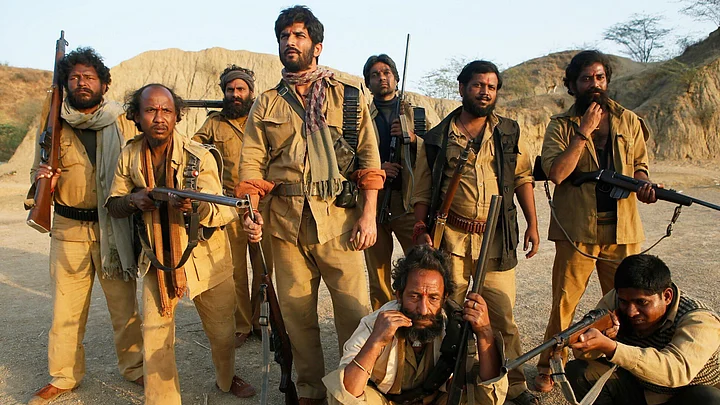Abhishek Chaubey’s Sonchiriya, while being described as a violent bandit drama, is so much more. It brings to the fore a lot that ails society in rural India, in particular the sharp lines of caste that divide India along with the deeply entrenched patriarchy. Set in 1975, the film is based in the lawless ravines of the Chambal where bandits live as rebels against society, but follow a code of their own. That this ‘baaghi ka dharam’, which is first and foremost about upholding their caste and tradition, becomes the driving force for the narrative of the film.
The story follows a Maan Singh (Manoj Bajpayee) and his gang of bandit Thakurs, for all practical purposes, the uppermost caste in this storyline. That lays the foundation for the first big differentiator of the film. Most Indian films in the past that have dealt with the subject of caste, have told their stories from the point of view of lower caste victims.
Sonchiriya has unsurprisingly been compared with Bandit Queen, with the most common criticism being the lack of sharpness given to the caste lines; but when the narrative follows a victim, it’s always easier to sharpen these lines. And while Tigmanshu Dhulia’s Paan Singh Tomar follows the story of a Thakur bandit too, the victimisation in that story was more to do with the protagonist’s past rather than his caste.
Sonchiriya delves into caste and community in a way that very few Indian films have, till date. The subject matter is presented such that it reflects reality without getting judgmental. Nobody’s the good guy here, and the film doesn’t go out of the way to show a society living under a shadow – you see a society living hand-in-hand with an age-old system. To these people, it’s just how things are. And therefore, what might appear to be inconsistencies to the casual urban viewer are just slices of reality from an era long gone and a land far off.
(SPOILER ALERT) The gang of Thakurs see nothing wrong in attacking a village of Gujjars, but the children they end up killing haunt them. The police officer in charge is a Gujjar himself, a community subject to widespread discrimination. He faces this even from his subordinates who don’t like taking orders from him. But he sees nothing wrong in threatening an entire village of Mallahs (boatmen) for information, only because he can.
While the extremes seen in this film have arguably mellowed in small town India over the last 45 years, those who have seen rural life in India’s cow belt will vouch for one thing – the ‘collective’ identity. An individual’s first line of identity is her/his caste or community. It isn’t strange even today forBrahmins to occupy one part of a village, while the lower classes live downstream from them.
The other thing Sonchiriya does brilliantly is to paint a lifelike picture of the deep-rooted patriarchy in this society. What’s ironic is that the narrative is pretty much scripted by the lone female character Indumati Tomar (played by Bhumi Pednekar) in the film.
It’s Indu who gives meaning and purpose to Sushant Singh Rajput’s Lakhna. As she rescues a 12-year-old rape victim, she splits the gang of bandits with a call to their collective conscience, albeit with a lie around the victim’s caste. Though Chaubey and co-writer Sudip Sharma don’t show us much of Indu’s life, in a very telling scene she instinctively pulls down her ghoonghat (veil) to cover her face nanoseconds before cocking her rifle at a potential male attacker.
In Sonchiriya’s world, women are just bags of flesh-and-bone. Their only purpose of being is to satiate the lust of men when they aren’t doing chores. They have no agency and the minute they do, they get branded as rebels. The fact that Indu’s teenage son spearheads the chase for her and believes he needs to kill his mother to extract revenge speaks volumes; even the mother-son bond is weaker than the patriarchy he’s lived with.
The position that women occupy in this society is best depicted in a scene involving a female bandit, Phuliya (believed to be based on Phoolan Devi). She invites Indu to join her gang but is met by refusal on the grounds that she’s a Thakur and can’t be part of a gang that is make up of lower castes. Phuliya responds saying that caste lines apply only to men and women are the lowest of them all.
The unapologetic portrait of prejudice and discrimination is what sets Sonchiriya apart. It paints reality, and doesn’t take sides – it just shows things for what they were and possibly still are in parts of India. It takes the merciless society, with its deep etched caste lines and patriarchy, and turns it into the most unforgettable character in the film.
Chaubey dissects the many facets of this character and lays it bare, leaving all judgment aside for the viewer to make. After all, everyone’s idea of the metaphorical sonchiriya (salvation) is different.
(At The Quint, we question everything. Play an active role in shaping our journalism by becoming a member today.)
